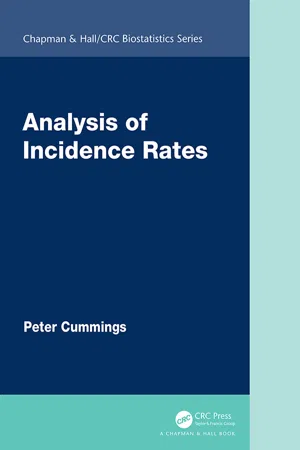
- 474 pages
- English
- ePUB (mobile friendly)
- Available on iOS & Android
Analysis of Incidence Rates
About This Book
Incidence rates are counts divided by person-time; mortality rates are a well-known example. Analysis of Incidence Rates offers a detailed discussion of the practical aspects of analyzing incidence rates. Important pitfalls and areas of controversy are discussed. The text is aimed at graduate students, researchers, and analysts in the disciplines of epidemiology, biostatistics, social sciences, economics, and psychology.
Features:
-
- Compares and contrasts incidence rates with risks, odds, and hazards.
-
- Shows stratified methods, including standardization, inverse-variance weighting, and Mantel-Haenszel methods
-
- Describes Poisson regression methods for adjusted rate ratios and rate differences.
-
- Examines linear regression for rate differences with an emphasis on common problems.
-
- Gives methods for correcting confidence intervals.
-
- Illustrates problems related to collapsibility.
-
- Explores extensions of count models for rates, including negative binomial regression, methods for clustered data, and the analysis of longitudinal data. Also, reviews controversies and limitations.
-
- Presents matched cohort methods in detail.
-
- Gives marginal methods for converting adjusted rate ratios to rate differences, and vice versa.
-
- Demonstrates instrumental variable methods.
-
- Compares Poisson regression with the Cox proportional hazards model. Also, introduces Royston-Parmar models.
-
- All data and analyses are in online Stata files which readers can download.
Peter Cummings is Professor Emeritus, Department of Epidemiology, School of Public Health, University of Washington, Seattle WA. His research was primarily in the field of injuries. He used matched cohort methods to estimate how the use of seat belts and presence of airbags were related to death in a traffic crash. He is author or co-author of over 100 peer-reviewed articles.
Frequently asked questions
Information
Table of contents
- Cover
- Half Title
- Series Page
- Title Page
- Copyright Page
- Table of Contents
- Preface
- Author
- 1. Do Storks Bring Babies?
- 2. Risks and Rates
- 3. Rate Ratios and Differences
- 4. The Poisson Distribution
- 5. Criticism of Incidence Rates
- 6. Stratified Analysis: Standardized Rates
- 7. Stratified Analysis: Inverse-Variance and Mantel-Haenszel Methods
- 8. Collapsibility and Confounding
- 9. Poisson Regression for Rate Ratios
- 10. Poisson Regression for Rate Differences
- 11. Linear Regression
- 12. Model Fit
- 13. Adjusting Standard Errors and Confidence Intervals
- 14. Storks and Babies, Revisited
- 15. Flexible Treatment of Continuous Variables
- 16. Variation in Size of an Association
- 17. Negative Binomial Regression
- 18. Clustered Data
- 19. Longitudinal Data
- 20. Matched Data
- 21. Marginal Methods
- 22. Bayesian Methods
- 23. Exact Poisson Regression
- 24. Instrumental Variables
- 25. Hazards
- Bibliography
- Index